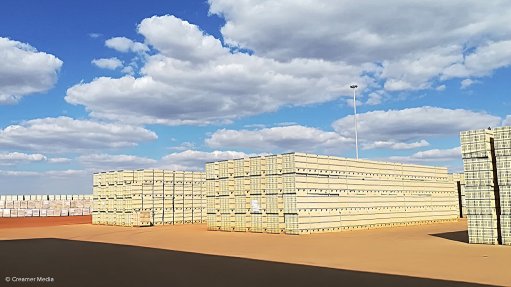
Bricks outside the new Kwastina factory
Photo by: Creamer Media's Tasneem Bulbulia
President Cyril Ramaphosa and Corobrik CEO Nick Booth on May 4 officially unveiled the company’s new R800-million Kwastina brick factory, in Driefontein, Gauteng.
Speaking at the unveiling, Booth described the factory as the most technologically advanced and environment-friendly brick manufacturing plant in Africa.
Corobrik plans to have at least 26% of the factory’s energy needs met by renewable energy sources and there are also plans to reduce gas emissions from the kilns by at least two-thirds.
Ramaphosa noted that the Kwastina factory was among the largest of its kind globally, as well as being the largest in Africa and South Africa.
“Kwastina is testament to our commitment to constantly innovate. It is an acknowledgement on our part that we need to progress and make those step changes to keep us relevant for the next 100 years,” Booth said.
The high-tech facility is fully automated, from the mixing of the raw materials to the end product.
It has the capacity to produce 100-million bricks a year, enabling it to meet large-volume orders.
Ramaphosa said this enhanced capacity would allow Corobrik to strengthen its exports to neighbouring countries.
Pioneering for the South African market would, however, be Kwastina’s ability to be flexible enough to produce small quantities of bespoke products for the architectural market.
Following a comprehensive analysis of Corobrik’s existing manufacturing process, the greenfield project resulted in the development of a new shaping plant, a new fully automatic wet side, a setting plant for direct setting, two tunnel dryers and two tunnel kilns, as well as a new unloading and packaging plant for dispatch packs without pallets.
“What makes this factory so exciting is that it allows us to compete anywhere in Southern Africa, landing product in regions traditionally not in Driefontein’s market, as the new factory is more cost-effective.
“It is going to give us an advantage in the market, not just in terms of technology, but also in terms of quality and consistency, which are critical for specifications involving tight tolerances,” Booth said.
Corobrik is expanding its product range, with various new products having already been introduced to the market.
Trials are also being carried out with brick glazing for bespoke projects, as well as the clay raw material to produce different colours to give Kwastina a unique footprint in the country.
Speaking to Engineering News & Mining Weekly, Booth said the biggest challenge to contend with was the Covid-19 pandemic, as this had an impact on the facility’s construction, with a three-month delay, owing to the initial hard lockdown from late March 2020.
Despite this, he said the company still managed to see the project, which began in 2019, to fruition.
The factory started full production at the end of March this year.
This project follows the commitment made at Corobrik at the South African Investment Conference at Sandton in 2019.
The R800-million investment has gone hand in hand with a further R20-million earmarked for the expansion of Corobrik’s concrete operations in KwaZulu-Natal.
“Kwastina produces clay face bricks, while the concrete operation is targeted at the plaster brick and block market,” Booth explained.
Ramaphosa lauded the project, saying it showcased that investment commitments made at the country’s Investment Conferences were becoming a reality.
He also said it would play a key role in the country’s economy, with construction being an integral part of the economy and vital to the efforts to recover from the impacts of the pandemic.
“I would like to thank Corobrik for, in a very literal way, committing to the country’s recovery,” he commented.
Moreover, he said the investment was a good example of government and business working together, with the Department of Trade, Industry and Competition having been involved in some of the processes.
The construction of the facility contributed to increased temporary employment, as well as skills development.